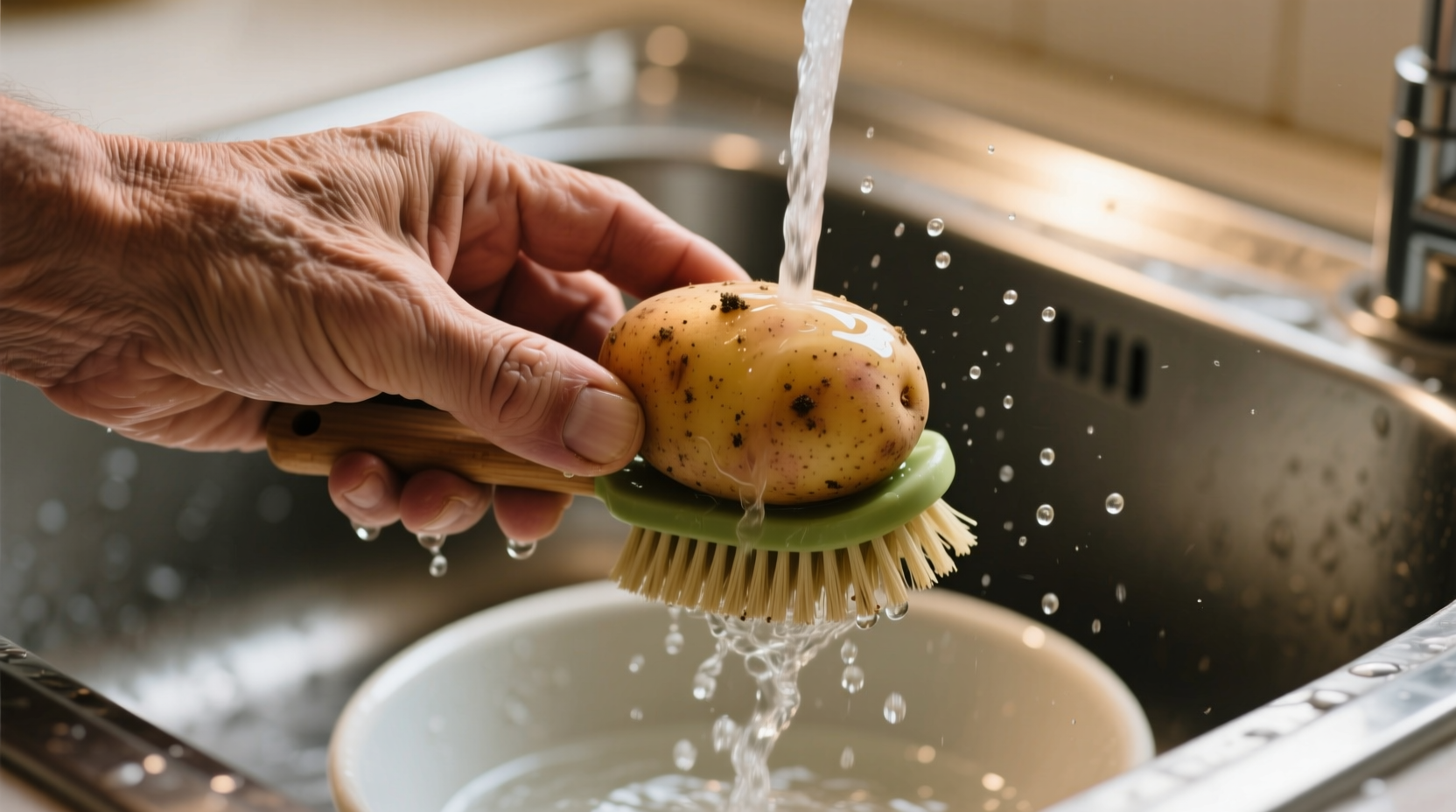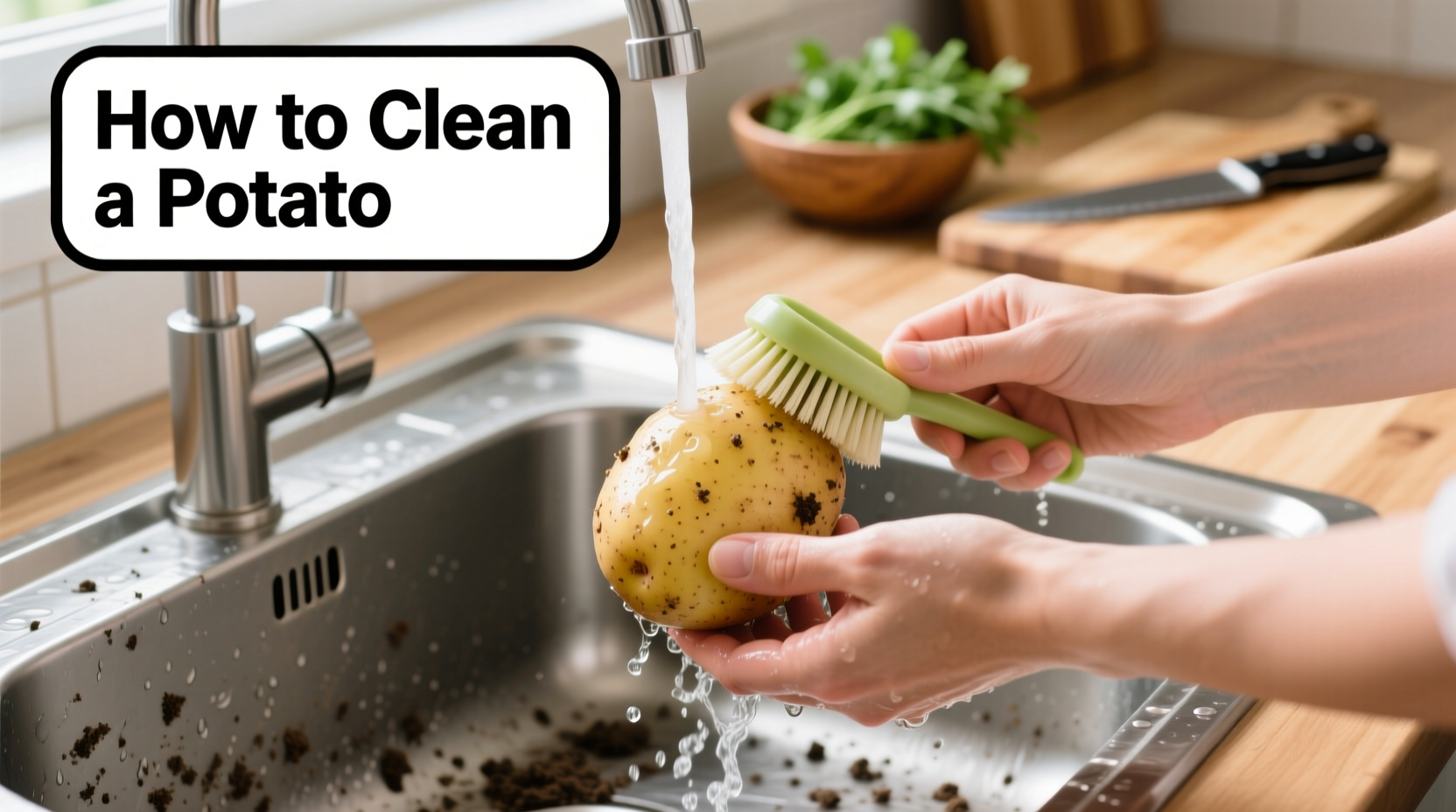Wash potatoes under cool running water using a vegetable brush to remove dirt and bacteria effectively. Never use soap or detergent. For best results, scrub gently while holding potatoes under flowing water for 20-30 seconds, then dry thoroughly before storing or cooking.
Why Proper Potato Cleaning Matters for Your Health and Cooking Results
Learning how to clean potato properly isn't just about removing visible dirt—it's essential for food safety and maximizing flavor in your dishes. Potatoes grow underground and often carry soil bacteria, pesticide residues, and other contaminants that require specific cleaning techniques to remove safely. The FDA recommends against using soap or commercial produce washes, as these can leave harmful residues that potatoes may absorb through their skin.
What You'll Need for Effective Potato Cleaning
Before you start cleaning potatoes, gather these simple tools:
- Cool running water (not hot, which can damage potato texture)
- Firm vegetable brush (never use metal scrubbers)
- Clean kitchen towel or paper towels
- Bowl or colander for rinsing
- Optional: White vinegar solution (1 part vinegar to 3 parts water) for extra cleaning power
Step-by-Step Guide: How to Clean Potato Properly
Step 1: Initial Inspection and Sorting
Examine each potato for significant damage, deep eyes, or green spots (which contain solanine, a natural toxin). Remove any potatoes with extensive damage that can't be properly cleaned. According to USDA food safety guidelines, minor imperfections can be cut away after cleaning.
Step 2: Rinse Under Cool Running Water
Hold potatoes under cool running water for 10-15 seconds to loosen surface dirt. Running water is more effective than soaking because it continuously flushes away contaminants. The FDA emphasizes that still water can redistribute bacteria rather than remove it.
| Cleaning Method | Effectiveness | Recommended For |
|---|---|---|
| Running water + vegetable brush | ★★★★★ | All potato types |
| Vinegar solution soak | ★★★★☆ | Conventionally grown potatoes |
| Dry brushing only | ★★☆☆☆ | Immediately cooking potatoes |
| Soap or detergent wash | ★☆☆☆☆ | Not recommended |
Step 3: Scrub Gently with a Vegetable Brush
This critical step in how to clean potato effectively removes embedded dirt. Apply moderate pressure while scrubbing in circular motions, paying special attention to eyes and crevices. A study from the University of Maine Cooperative Extension found that brushing under running water removes up to 98% of surface bacteria compared to 85% with rinsing alone.
Step 4: Special Treatment for Different Potato Types
Russet potatoes with thick skins require more vigorous scrubbing than delicate fingerling or new potatoes. For organic potatoes with visible soil, consider a vinegar solution soak (1 part vinegar to 3 parts water) for 5-10 minutes before scrubbing. Never use this method for potatoes you plan to store, as moisture encourages spoilage.
Step 5: Final Rinse and Drying
Rinse thoroughly under running water to remove any loosened dirt or cleaning solution. Dry potatoes completely with a clean kitchen towel before storing or cooking. Moisture left on potatoes creates an environment where bacteria can grow rapidly. Proper drying extends shelf life by up to 30% according to agricultural extension research.

Common Potato Cleaning Mistakes to Avoid
Many home cooks make these critical errors when learning how to clean potato properly:
- Using hot water - damages potato texture and can cause nutrient loss
- Soaking for extended periods - makes potatoes waterlogged and less flavorful
- Skipping the drying step - leads to faster spoilage and poor cooking results
- Cutting before cleaning - allows bacteria to enter the potato flesh
- Using soap or detergent - FDA warns against this as potatoes can absorb residues
When to Peel vs. When to Keep the Skin On
Potato skins contain valuable nutrients and fiber, but require proper cleaning. The National Potato Council reports that up to 50% of a potato's fiber and significant amounts of potassium and vitamin C are concentrated in or just below the skin. Only peel potatoes when they have deep eyes, significant damage, or if your recipe specifically requires it. When properly cleaned, potato skins add texture and nutrition to dishes.
Storing Cleaned Potatoes Properly
After learning how to clean potato effectively, proper storage ensures your effort pays off. Store cleaned and dried potatoes in a cool, dark, well-ventilated place—not in the refrigerator, which converts starch to sugar. Never store potatoes in plastic bags, which trap moisture and accelerate spoilage. For best results, place them in a paper bag or cardboard box with ventilation holes. Properly stored cleaned potatoes maintain quality for 1-2 weeks.
Special Considerations for Different Cooking Methods
The way you clean potatoes should vary slightly based on your cooking method:
- For roasting or baking: Clean thoroughly but leave skin on for texture and nutrients
- For mashed potatoes: Clean carefully around eyes, which can impart bitter flavors
- For frying: Ensure potatoes are completely dry before cutting to prevent oil splatter
- For salads: Consider a vinegar solution rinse to remove excess starch
Food Safety Timeline: From Cleaning to Cooking
Understanding the proper timeline for cleaned potatoes prevents food safety issues:
- 0-2 hours after cleaning: Ideal time for cooking—potatoes are clean but still fresh
- 2-24 hours after cleaning: Must be refrigerated if not cooked immediately
- 24+ hours after cleaning: Quality and safety decline significantly—discard if stored this long











 浙公网安备
33010002000092号
浙公网安备
33010002000092号 浙B2-20120091-4
浙B2-20120091-4